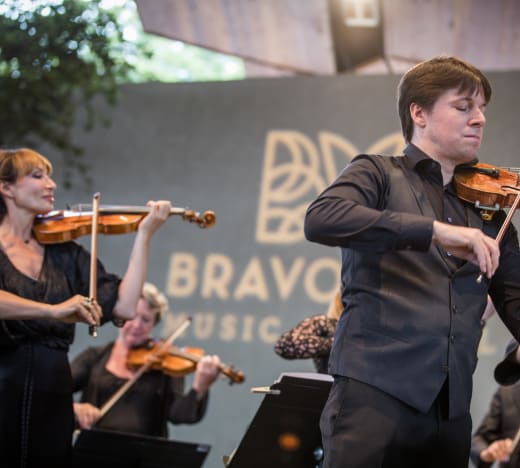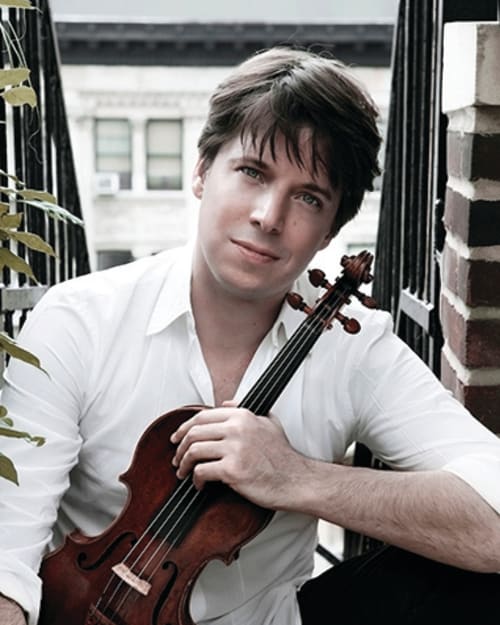
Photo Zach Mahone
Joshua Bell with Academy of St Martin in the Fields
Academy of St Martin in the FieldsJoshua Bell demonstrates why he is one of the greatest violinists of his era in Paganini’s virtuosic Violin Concerto No. 1, alongside ASMF performances of Schumann’s transcendent Symphony No. 2 and Beethoven’s Overture to Egmont.
Renowned for its beautifully refined sound and vibrant interpretations, the Academy, led by Music Director Joshua Bell, makes a triumphant return for its fourth residency at Bravo! Vail.
All artists, programs, and pricing are subject to change.
Program Details
Joshua Bell, violin
BEETHOVEN Overture to Egmont
PAGANINI Violin Concerto No. 1
SCHUMANN Symphony No. 2
Guest Artist

Joshua Bell
Joshua Bell
violin
Joshua Bell (violin), born in Bloomington, Indiana, has for over forty years been heard as a soloist, chamber musician, recording artist, conductor and director, and Grammy Award winner. Bell has served as Music Director of the Academy of St Martin in the Fields since 2011, and his 2022/23 season highlights with the Academy include touring to eight countries throughout Europe and South America. This summer's performances mark Bell's fourth appearance at Bravo! Vail with the Academy.

Program Notes
Overture to Egmont, Op. 84 (1809-10)
LUDWIG VAN BEETHOVEN (1770-1827)
Overture to Egmont, Op. 84
Ludwig van Beethoven managed to complete only one opera and two ballets, but he left more numerous offerings in the area of incidental music for stage plays. His incidental music ranges from single numbers to multi-movement collections crafted for a half-dozen dramas. Except for Goethe’s Egmont, all of them would be profoundly forgotten in most quarters but for Beethoven’s contributions to their productions. Beethoven idolized Goethe, whom he referred to as “the foremost German poet,” and when the Vienna Hoftheater commissioned the composer to write music for an 1810 revival of Goethe’s 1786 tragedy Egmont, he leapt at the opportunity, providing an overture plus nine movements to fit within the play itself. The subject appealed to Beethoven’s political taste, derived as it was from a 16th-century historical incident in which Count Egmont (a Flemish nobleman) defied occupying Spanish forces and sealed his own doomed fate in order to afford his people a vision of freedom. Beethoven wrote to Goethe, adopting a tone of uncharacteristic humility: “You will soon receive my music for Egmont—this wonderful Egmont which I read and felt and set to music thinking warmly of you. I am eager to know what you think of it. Even censure will be beneficial to me and my art and will be just as welcome as unmitigated praise.” Goethe, it turned out, was very pleased.
According to traditional lore, the slow introduction of the Egmont Overture depicts the Flemish populace suffering under the yoke of Spanish oppressors. This leads to a rapid section meant to suggest the optimistic spirit of revolt harbored by the Flemish citizens and, at the end, a celebratory climax symbolizing their victory over oppression. That climactic music would return at the play’s end under the title Siegessinfonie—Symphony of Victory.
Violin Concerto No.1 in E-flat major, Op. 6 (1816)
NICCOLÒ PAGANINI (1782-1840)
Violin Concerto No. 1 in E-flat major, Op. 6
Allegro maestoso
Adagio
Rondo: Allegro spiritoso
The 19th century gave rise to a small army of ultra-virtuosos, with the pianist Franz Liszt and the violinist Niccolò Paganini leading the charge. Paganini played an audience fully as well as he played the violin, and his instincts for public relations were uncanny. As impressive as his technical skill was, he seems to have invariably used it to heighten emotional effect rather than to merely titillate the ear. Franz Schubert, who in 1828 (the last year of his life) managed to attend three of Paganini’s concerts in Vienna, marveled, “In Paganini’s Adagio I heard an angel sing.” Berlioz, Chopin, and Liszt added accolades, and literary lions helped fuel the flames of Paganini mania throughout Europe. Paganini included his Violin Concerto No. 1 (one of six) in the initial program of his Vienna residency. Completed in 1816, it was already by then one of his principal warhorses, crafted to spotlight his extraordinary technical arsenal. Its barrage of double stops, harmonics, double-stopped harmonics, and quickly alternating forms of articulation—not to mention melodic writing that is spun out over the extraordinary range of four octaves—were unprecedented in Paganini’s time. Though all of these techniques went on to become essential skills for modern violinists, they can still leave listeners amazed. Technical wizardry, however, is not the entire story here, and it should not obscure that the E-flat-major Concerto is a well-knit piece in the classical tradition. Its themes are not complex, but as with the operatic melodies of his contemporaries in the opera world (most notably Rossini, but also other figures of the bel canto tradition), they can be insistently memorable; the second theme of the imposing first movement is only one of several tunes that lodge themselves in the mind.
Intermission
Symphony No. 2 in C major, Op. 61 (1845-46)
ROBERT SCHUMANN (1810-56)
Symphony No. 2 in C major, Op. 61
Sostenuto assai—Allegro, ma non troppo
Scherzo: Allegro vivace
Adagio espressivo
Allegro molto vivace
By the time he wrote his C-major Symphony, in 1845-46, Robert Schumann had already completed his Symphony No. 1 (the Spring); his Overture, Scherzo, and Finale (essentially a symphony without a slow movement); and the first version of his D-minor Symphony (which eventually become his Symphony No. 4). He therefore had quite a lot of experience as an orchestral composer. Nonetheless, his creative life was imperiled. He was showing increasing signs of serious mental and physical illness. Clara Schumann wrote of her 34-year-old husband: “Robert could not sleep a single night. His imagination painted him the most fearful pictures. Early in the morning I usually found him bathed in tears.”
But then came the day when he wrote, in a letter to Felix Mendelssohn: “Drums and trumpets in C have been blaring in my head. I have no idea what will come of it.” What would come of it, we imagine, was the fanfare-like motto that opens the C-major Symphony and recurs again in that work’s Scherzo and near the end of its finale. Gradually he recovered the will to continue. In December, his creative juices started to flow, and in the space of about three weeks he composed the entire symphony, at least in its essentials. He later stated that he suspected (probably wrongly) that people would hear that he had been ill when he wrote this piece; “only in the final movement did I begin to feel my old self again, but it was only after I had completed the whole work that I really felt any better.” Certainly, this symphony is not an autobiographical study in illness or depression, yet its flavor is distinctive in a way that is hard to put one’s finger on, with an overall feeling of hard-won affirmation and triumph.
Did you know?
The spotlight is on the “chamber” part of chamber orchestra, with a program that marries powerful music with small-scale intimacy.
